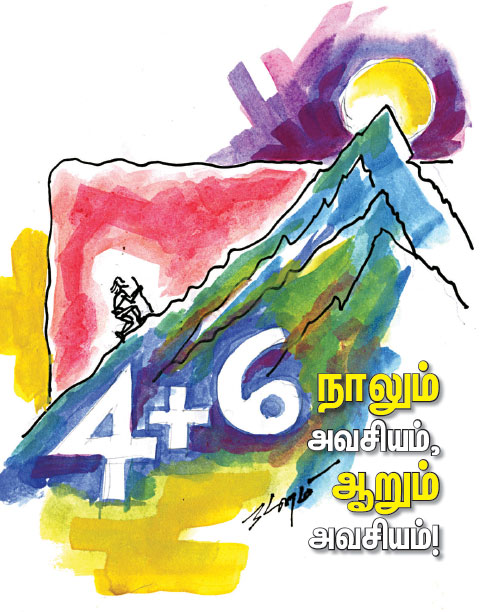Kaivalliya Navanītham
P.N. Parasuraman. Images:
Nataṉam
Four is essential, six is essential!
The boys and girls holding the cellphone in their hands move their
thumbs so fast over the keyboard it takes the breath away.
Who taught them to play with their thumbs in lightning speed? No one!
They learnt it by themselves.
The cause is their unrelenting devotion and practice.
If you want to divest yourself from difficulties, hardship…and live
happily, we should have an ardent devotion (desire) to accomplish it.
Just like the children learn to manipulate the cellphone keyboard
fast and furious and with pluck and pizzazz, we must learn certain
things.
Kaivalliya Navanītham,
divided into four sections for our education and instructions, begins
with explication of Tattva in the first section.
The first lesson. There is a mention of four matters we should know.
Like it or not, it is mandatory for us to know them. The why of it, we
will find out later.
1.
The wisdom to know the eternal and the non-eternal decisively.
2.
Giving up desire for sensual delights in this world and the heaven.
3.
Samādhi
including six Guṇas.
The next verse describes them.)
4.
Desiring for Mukti (Liberation).
Having these four is enough. We will be in good shape. These four are
essential for those desiring for tranquillity, peace and Mukti. But
there is a problem.
Though the first reading appears to give us an understanding of the four
entities, it is hard to understand the basis, the depth, the dense
Truths… So what. Delving deep in the discovery of depth and the density
of Truths makes life interesting.
1.
Eternal and non-eternal: the determinative wisdom to know them. Only
when the eternal is stable, we can operate the unsteady (entity).
As an example, the rails under the railway cab (car) are
stable
and stay put in one place.
The rail cars are unstable, running over them.
While the wheels of the rail cars are spinning, the seats in the cabs or
cars are stable. But we the people sitting on the stable seats are
unstable. We never understand that truth.
We mistakenly think of our permanence, borrow up to the hilt, buy
unwanted stuff (needed or not) and amass them. When someone points out
this conspicuous consumption, the
spendthrift
says, “What do you mean? This life is for once. When you
depart, what do you take (with you)? For the duration of life on earth,
let us experience and enjoy all we can. Get a life.” Such is the
philosophical outlook of the spendthrift.
We should know the Eternal from the non-eternal.
2.
Shedding of desires of the Bhoga of this world and the supreme world
(heaven).
It is just not enough to have the wisdom to know the Eternal and the
non-eternal. Though we were told about the rails, the cars and the seats
a thousand times, we never changed.
In this world, to lead a good life, we face unbearable difficulties. We
receive half of what we desire; we are despondent thinking whether we
will get the other half. Assuming we receive the whole enchilada, we
desire for more. We try to stuff 5000 liters in a five-liter vessel.
This, only in this world! Wishing to go to Swarga Loka, we indulge in Māntrica
and Tāntrica
rituals to obtain supernatural powers by Mantras and Tantras.
The results..?
King Nakuṣa
lived a great life on earth and performed Yāgams.
Because of it, he obtained the seat and power of Indra. Though he went
to Svarga Loka, his impatience and haste earned a curse from Agasthiyar
and he fell in disgrace on the earth as a snake. All his efforts and the
hardships came to nil.
This is the reason Kaivalliya Navanītham
recommended relinquishing the desire for sensual delights in this world
and svarga.
Hold it in your memory... Jñāṉa
treatises do not say that in life you should not have joyousness. They
say excessive and insatiable desire are not advisable.
Relinquishing desire: Is it practicable?
Yes, it is, says Kaivalliya Navanītham.
It also delineates the ways.
3.The Six Guṇas…
4. The desire for Mukti. That is the desire for attainment of Mokṣa.
These four are Sādhana
Sathuttayam (Sādhana
Catuṣṭaya = means of aggregate of four.) It means these four means
(devices) exist for our body, mind and morals.
The third one in the four entities is Samādhi.
Samam,
Tamam,
Vidal,
Sahiththal,
Samādhānam,
and
Sraddha
are the six qualities.
1.
சமம்
= Samam: Bringing mind, Buddhi, Ahaṅkāram, and Siddham under one’s
control.
2.
தமம்
= Dhamam: To bring the ten organs under one’s control.
3.
விடல்
= Vidal: To reduce family matters gradually. Thought it is impossible at
young age. At least at 50, one must diminish his burden of the family
matters gradually. One should make an attempt.
4.
சகித்தல்
= Sahiththal:
Treat pleasure and pain alike. The pleasure and pain, unbearable as they
are, should be treated in equable measure as the examples of Prarabda
Karma.
5. சமாதானம்
= Samādhānam
= Concentration of mind. Not
only eagerly listening to the meanings of the Veda Vedhānthangal
one should reflect on them: That is Samādhānam.
6.
சிரத்தை
=
Siraththai = Keen interest.
Paying love and respect to the greatest Gurunāthar and his
Vedanta Sastras.
Kaivalliya Navanītham says these are the six inclusive of Samādhi.
Following this, there is a presentation of abbreviated questions and the
appropriate clear answers. Let us see who the questioner is and the
answerer.
Will continue…
